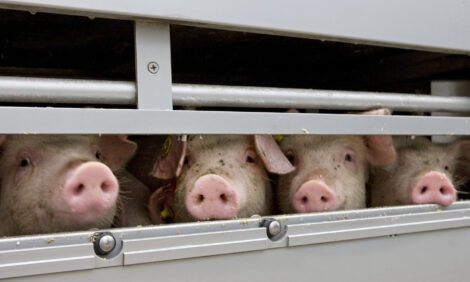



Market & Supply
CANADA - Jim Long's Weekly Pork Commentary this week focuses on the unexpectedly high US hog slaughter numbers. Jim Long President, Baconmaker Genetics / Wood Lynn Farms, Inc. |
| Last Week This Year | 1.823 |
| Last Week Last Year | 1.810 |
We had expected that by now slaughter volumes would be under year-ago levels. Most other analysts thought so, too, and USDA's June 1 H&P supported this expectation. So what's happened?
- More slaughter hogs coming from Canada. We have no facts but suspect more Canadian hogs are finding their way to U.S. slaughter plants. The mad cow problem in Canada has kept Canadian beef at home and forced cattle prices so low that hogs have to go to the U.S. to find a market that isn't competing with dirt-cheap beef. Consequently, 10-20,000 extra hogs/week are being marketed in the U.S. instead of Canada. This pushes U.S. weekly kills up about 1%.
- Friendly growing weather. Cooler than normal weather this summer has reduced the braking effect of summer on production.
- Hogs have been doing better with less appetite-suppressing heat. They have been getting heavier and doing it faster than normal for this time of year.
- Mortality is taking a lower toll in barns and in transit.
- Breeding herd liquidation is adding to volume. Sow slaughter has been running ahead of year ago since the 1st of June (and in this quarter last year the breeding herd decreased 145,000). Moreover, we see little indication of enhanced gilt retention. Gilts not retained add to slaughter volume.
Unfortunately, though, while 58 cents is better than year ago it's not sufficiently backfilling the equity hole most producers dug trying to hang in there the last few years. Many producers are depressed and discouraged. Raising hogs is hard work. Used to be, there was money to be made with that hard work. Now, many producers and their families are questioning their destiny. Is it ever going to get better? Is there a worthwhile and future role for independent producers? These are good and relevant questions but no answer is available.
There are, however, some other relevant questions that do have an answer. They are questions about things producers can control:
- Do you like the swine business well enough to fight on?
- Are you technologically competitive?
- How about your nutrition?
- How about your genetics?
- Is your economic strategy up to the challenge?
- Are you ready to use Futures Options to manage financial risk?
- Do you have a supportive financial institution to work with?
- The pig crop this spring was the smallest since 1996. We expect similar results in the summer and fall pig crops. Fewer pigs support prices. In the fall of 1996 live hogs were 55 cents/lb.
- The corn and soybean crop will be such to push down feed costs and lower the cost of production.
Genetics Industry
The financial debacle that has hammered the hog industry has been hard on the swine genetics industry. Declining breeding herd inventories and negative producer cash flows have led to decreasing genetics sales. A case in point is the Cotswold swine genetics company.
Originally a British company, Cotswold first came to North America as an arm of the Master Mix/Central Soya feed company. After a few years of little success and major financial losses the franchise was taken over by Heartland Pork. Later, the Ridley Corporation, owners of Feedrite in Canada and Hubbard Feeds in the U.S., bought Cotswold.
Ridley, being a public company, regularly releases its financial records. In several financial quarters it indicated losses of $2 million for Cotswold. A year ago, Ridley sold Cotswold in the United Kingdom to the JSR group and Ridley wrote off approximately $10 million of their British investment. This past week, Ridley announced a potential sale of Cotswold. If the sale is completed Ridley expects to write down between $10 & 15 million further.
Operating losses and write downs related to Cotswold amount to nearly $30 million. That's a lot of money and it's a reflection of how tough the swine genetics business is. Even though Ridley has been a successful company and they had the will and capital to make Cotswold work, the market circumstances were too great for them to overcome.
It's rumored that PIC is the buyer of Cotswold. Consolidation continues.
Mad Cow (BSE) Update
Few, if any, countries in the world are as reliant on exports as Canada. 70% of Canada's beef and 45% of its pork production is exported. So the mad cow problem Canada has is one of monumental proportions and its livestock and cattle industries continue to reel from the fallout of mad cow in Canada.
- Slaughter steers were selling for 27 cents/lb in Canada last week. Just across the border they were selling for 77 cents/lb in the U.S.. On a per head basis the difference amounts to over $600. Cheaper cattle in Canada is pushing more Canadian hogs across the border to U.S. markets.
- McDonald's Canada got behind Canadian beef, announcing a plan to purchase only Canadian beef. Big of them. It probably had nothing to do with the price of Canadian beef being so low. Question is, will they pass on the savings by lowering the price of hamburgers?
- For the first time, a Canadian government official made an openly pessimistic statement about the timetable for re-opening the border. This past week it was reported that Francine Lord, National Manager of Imports and Exports with the Canadian Food Inspection Agency (Canada's Agriculture Ministry), said:
- "the border won't re-open to live cattle for years."
- "that likely, countries will consider mad cow too risky to resume live cattle imports but would resume beef, bovine semen and embryos."
| Published with permission from |
Information provided by |
Source: Jim Long, www.baconmaker.com. Reproduced courtesy Farms.com - 28th July 2003








